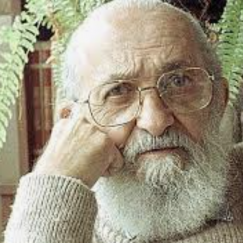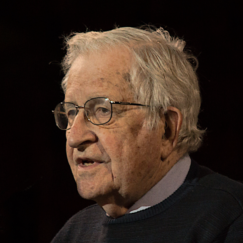If students are not trained to ask basic questions about the images which confront them, if they are not asked to examine the knowledge and assumptions which they already possess, they are being denied the opportunity to develop the most simple and essential critical tools.
Bio/Short Description
Theodor W. Adorno was a German philosopher, sociologist, and composer known for his critical theory of society. He was a leading member of the Frankfurt School of critical theory, whose work has come to be associated with thinkers such as Ernst Bloch, Walter Benjamin, Max Horkheimer and Herbert Marcuse, for whom the works of Freud, Marx, and Hegel were essential to a critique of modern society. He is widely regarded as one of the 20th century's foremost thinkers on aesthetics and philosophy, as well as one of its preeminent essayists. As a critic of both fascism and what he called the culture industry, his writings—such as Dialectic of Enlightenment (1947), Minima Moralia (1951) and Negative Dialectics (1966)—strongly influenced the European New Left.
Other Grandparents
 Marlon Posted By: Renee HobbsOn:11/29/2023 - 00:56
Marlon Posted By: Renee HobbsOn:11/29/2023 - 00:56
 danahPosted By: Yonty FriesemOn:01/06/2023 - 07:34
danahPosted By: Yonty FriesemOn:01/06/2023 - 07:34
 PaoloPosted By: Renee HobbsOn:07/22/2021 - 16:11
PaoloPosted By: Renee HobbsOn:07/22/2021 - 16:11
 NoamPosted By: Renee HobbsOn:05/23/2020 - 03:48
NoamPosted By: Renee HobbsOn:05/23/2020 - 03:48
 Jon Posted By: Renee HobbsOn:05/10/2020 - 00:12
Jon Posted By: Renee HobbsOn:05/10/2020 - 00:12



Gianna Cappello
Adorno has basically accompanied my entire intellectual life, from my early high-school years, back in a small town in southern Italy, to my university time in Catania, when I was inspired by the devastating critique made by Jerzy Kosinski in his novel Being There (1970) and decided to write my thesis about television. Adorno’s critical views about mass culture supported my argument against the negative effects of television and a national television system in which Silvio Berlusconi’s commercial networks had definitely won it all, so to speak, against quite traditional (and, I must say, rather boring) public-service broadcasting (RAI) and were thus ready to support him in his rising political career.
I encountered his ideas again during my graduate studies at the University of Illinois at Urbana-Champaign in the early 1990s. I thought I had gone there to study media and communication (which, in fact, I did, albeit with an unexpected approach), but instead, there I was, attending my very first Cultural Studies class, held by a ponytailed Larry Grossberg who, sipping a Diet Coke while sitting on his desk, introduced his syllabus by dropping names such as Baruch Spinoza, Immanuel Kant, Theodor Adorno, Walter Benjamin, Louis Althusser, and Antonio Gramsci but also Umberto Eco, Michel de Certeau, Stuart Hall, John Fiske, Dick Hebdige, Angela McRobbie, David Morley, Gayatri Spivak, and many others. Some I already knew, but a lot of them were totally new to me.
As I learned in the following weeks, these people were part of the “theoretical legacies” of cultural studies and were all somehow related to the notion of mediation, to the relationships between subjectivity and structure, culture and power. I learned that the media’s negative effects and audiences’ passivity could not be taken for granted (as I thought when I wrote my undergraduate thesis). I learned that popular culture—redefined as “lived experience” and “polysemic”—represents an important symbolic resource that people actively use in their everyday life to make sense of the world and “resist” dominant culture, as proved by innumerable ethnographic studies. It was indeed a huge sigh of relief to be able to slightly untighten the leash of puritanical critical theory toward the manipulative mechanisms of “the system” and the alienating ideology of the culture industry.
That was when I started to question my Adornian views about popular culture, to “wrestle with my angel,” as Stuart Hall would put it—not so much in the sense that I wanted to give up on him but as a “problematic” (again, Hall’s term) that is as much about struggling against the constraints and limits of Adorno’s ideas as about the necessary questions I still felt he required me to address.
Eventually, when I returned to Italy in the mid-1990s, I casually met Roberto Giannatelli, who—together with some colleagues from the Catholic University in Milan, a couple of media professionals from RAI (the Italian public-service broadcasting), and a group of gutsy middle-school teachers—was about to found the Italian Association for Media Education (MED).
At local and national levels, we then started to meet and train dozens of teachers, trying to convince them that their critiques of popular culture were in fact an act of cultural elitism toward their students, whom they snobbishly looked at as cultural dupes, and that we needed to think of them as actively committed in diverse and creative interpretations of media messages. And yet, although I am still fascinated by the notion of the “active audience,” throughout these years I have always been somehow unsatisfied with the simplistic and somewhat caricaturist Adornian vulgate that this notion seems to assume. In other words, like a karstic river that you don’t see but know it flows somewhere underneath, Adorno has always been there, a nagging presence to remind me that the story is a bit more complex and that we constantly need to reconstruct—beyond the traps of binary thinking (powerful media versus active audience, manipulation versus resistance, culture as ideology versus culture as lived experience, etc.)—the intricate interplay between popular culture and everyday life, and popular culture and/as everyday life.
Adorno continues to fuel my uneasiness with the populist views about the power of the people to subvert or circumvent dominant structures of power and also reinforcing my conviction that education (like art) is the key to “a life without fear,” as he would put it. Education (and art) can help us look history straight in the eyes—that is, lucidly look at the limits and constraints of contemporary popular culture (at a macro level) and yet be able to develop with our students (at a micro level) ways of interacting with it in more creative and critical ways and, in doing so, posit an “otherwise” that is currently unavailable.